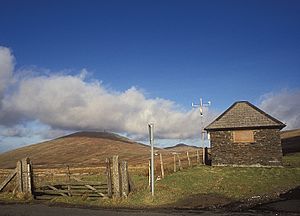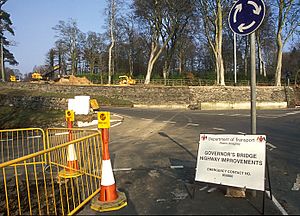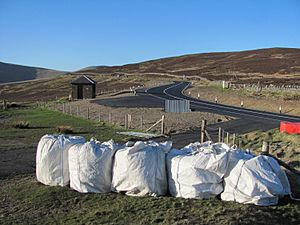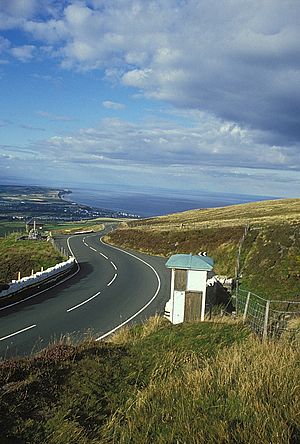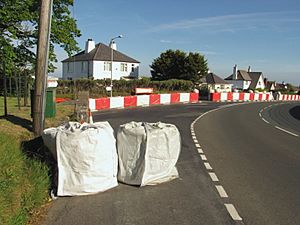Isle of Man TT Mountain Course facts for kids
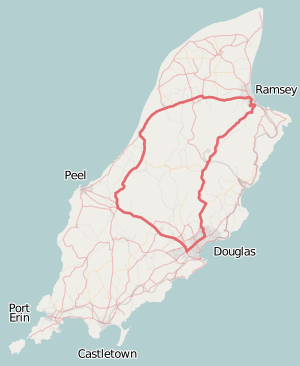 |
|
| Location | Douglas, Isle of Man |
|---|---|
| Time zone | British Summer Time (during event-season) |
| Major events | Isle of Man TT Manx Grand Prix Sidecar World Championship (1960-1976) |
| Length | 37.730 mi (60.718 km) |
| Turns | 219 |
| Race lap record | 16:42.778 seconds – 135.452 mph / 217.99 kmh average (Peter Hickman, BMW S1000RR, 2018) |
The Isle of Man TT Mountain Course is a famous road circuit on the Isle of Man. It's used for exciting motorcycle races like the Isle of Man TT and the Manx Grand Prix. Imagine racing on public roads! This course is known for being one of the most challenging in the world.
The race starts in Douglas, Isle of Man, the island's main town. Riders go clockwise around the course, which is about 37.730 mi (60.721 km) long. They zoom through city streets, then out into the countryside. The course passes through villages like Braddan and Union Mills. It also goes over the A18 Snaefell Mountain Road. This road takes riders to the highest point of the course, about 1,385 ft (422 m) above sea level. Finally, the course winds back down to Douglas.
Contents
History of the TT Course
Motor racing started on the Isle of Man in 1904. Back then, cars raced because the United Kingdom had speed limits on public roads. The Isle of Man allowed racing on its roads. The first car race used a 52.15 mi (83.93 km) course.
Motorcycles joined in 1905. The mountain roads were too steep for early motorcycles. So, a shorter 15 mi (24 km) course was used for the 1907 Isle of Man TT. Over time, the course changed. By 1911, the course became known as the Isle of Man TT Mountain Course. It was about 37.50 mi (60.35 km) long.
How the Course Changed Over Time
The TT Mountain Course has been updated many times. In 1920, the start and finish line moved to Glencrutchery Road. This made the course slightly longer, about 37.75 mi (60.75 km). Roads were widened in many places, like at Sulby Bridge and Braddan Bridge. Corners were also made smoother.
More changes happened in the 1930s. A hump-backed bridge at Ballig was removed. Roads were widened at places like Laurel Bank and Glen Helen. A sheep-gate at Brandywell was also taken away. These changes made the course safer and faster. The official length became 37.73 mi (60.72 km), which is what it is today.
After World War II, improvements continued. In the 1950s, more road widening happened. Corners like Bedstead Corner and Gorse Lea were made wider. Some buildings, like a cottage at Appledene, were removed for safety. A hotel at the Bungalow was also taken down.
In the 1960s, a roundabout was added at the Quarterbridge. Later, in the 1970s and 80s, more sections like Verandah and Quarry Bends were widened. These changes helped make the course better for racing.
Recent Course Updates
Since 2000, the course has seen more modern updates. Roads were repaired and widened at places like Handley's Corner and Windy Corner. In 2008, a new roundabout was built at Braddan Bridge. A new link road was also created near Governor's Bridge.
Safety was a big reason for these changes. For example, a grass bank was removed at Keppel Gate in 2009. This created more run-off space for riders. Road surfaces were also improved in many areas, including Quarter Bridge and Hillberry Corner.
Amazing Lap Records
The TT Mountain Course is famous for its incredible speed records. The fastest lap ever was set by Peter Hickman in 2018. He completed the Senior TT race lap in 16 minutes and 42.778 seconds! This means he averaged an amazing 135.452 mph (217.989 km/h).
Sidecar teams also race here. Ben and Tom Birchall hold the sidecar lap record. They finished a lap in 19 minutes and 22.928 seconds in 2016. Their average speed was 116.798 mph (187.968 km/h).
The unofficial top speed record on the course is 206 mph (332 km/h). This was achieved by Bruce Anstey on the Sulby straight in 2006.
Other Uses of the Course
The TT Mountain Course isn't just for motorcycles!
Cycling Races
Cyclists also use this challenging course. Since 1936, it has hosted cycle races, including the Manx International. In 2017, it was used for the British National Road Race Championships.
The fastest cycling lap record was set in 2015 by Peter Kennaugh. He completed the course in 1 hour, 23 minutes, and 48 seconds. That's super fast for a bicycle!
Car Records
Cars have also set impressive records on the course. In 1990, Tony Pond was the first to complete a lap at an average speed of over 100 mph (160 km/h) in a Rover car.
More recently, Mark Higgins, a rally driver, broke his own record in a Subaru Impreza. In 2016, he drove a lap in 17 minutes 49.75 seconds. This was an average speed of 126.971 mph (204.340 km/h)!
Named Corners
The TT Mountain Course has over 200 corners! About 60 of them have special names. Many are named after famous riders or important events.
For example, Brandish Corner was named after Walter Brandish. He crashed there in 1923. Birkin's Bend is named after Archie Birkin, who sadly died there in 1927. After his accident, practice sessions for the TT races began to be held on closed roads.
Handley's Corner is named after Wal Handley, who crashed there in 1932. In 1939, a memorial to Jimmie Guthrie was built at "The Cutting," and that S-bend corner was renamed Guthrie's Memorial.
More recently, corners have been named after modern TT legends. In 2003, the 32nd Milestone was named "Duke's" after Geoff Duke. The 26th Milestone became "Joey's" after Joey Dunlop, who won 26 TT races. In 2013, corners were even named after active riders, John McGuinness and Dave Molyneux.
Safety on the Course
Safety is a very important topic for the TT Mountain Course. Over the years, many changes have been made to make racing safer.
The first fatality on the course happened in 1911. After a fatal accident in 1913, crash helmets became compulsory for the 1914 races. Also, a special flag was introduced to signal the end of a race.
In 1927, a rider named Archie Birkin died during practice. He swerved to avoid a fish-van on an open road. After this, all practice sessions for the TT races were held on closed public roads. This was a major safety improvement.
In the 1930s, "Travelling Marshals" on motorcycles were introduced. Their job was to search for missing riders, especially in bad weather. Races also started to be delayed or postponed if the weather was too bad.
After several accidents in the 1950s, more road widening and improvements were made. The way riders started races also changed to improve safety.
In 2004, a "Newcomers Speed Control Lap" was introduced. This helps new riders learn the course safely. A special TT Mountain Course licence is now required for all competitors.
After a serious accident in 2007, many new safety measures were put in place. These include restricted areas for spectators, safety fencing, and "air-fencing" at corners. Air-fencing is like a giant inflatable cushion that helps absorb impact in a crash.
In 2018, new rules were made for "red-flag" incidents (when a race is stopped due to an accident). Now, riders wait on the course and travel only in the race direction, with marshals guiding them. GPS tracking was also added to course inspection cars. These ongoing efforts help make the TT Mountain Course as safe as possible for everyone involved.
See also
 In Spanish: Snaefell Mountain Course para niños
In Spanish: Snaefell Mountain Course para niños


